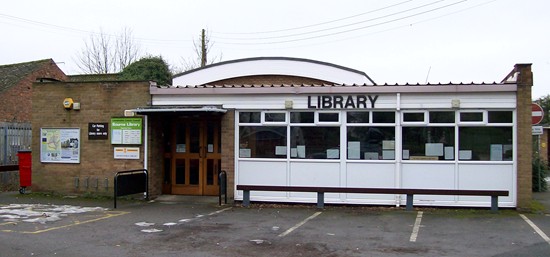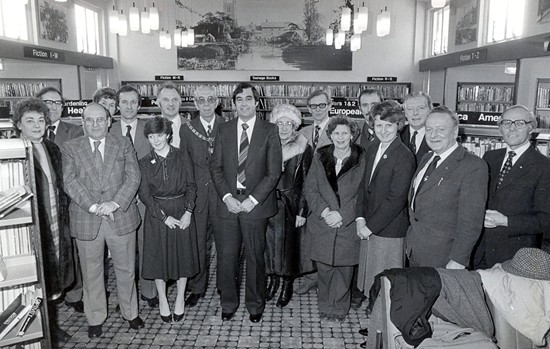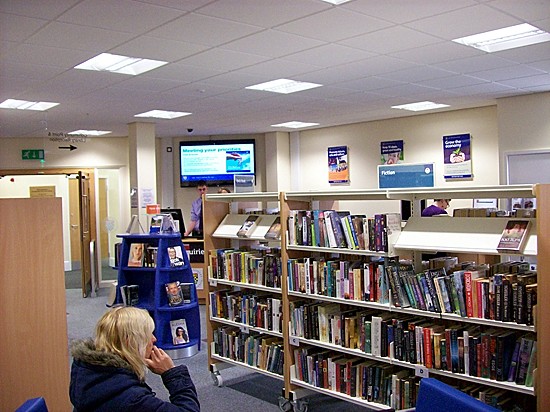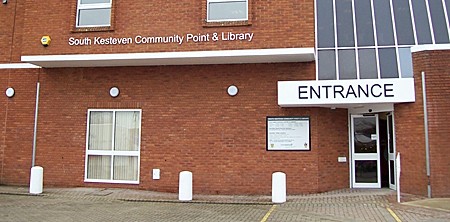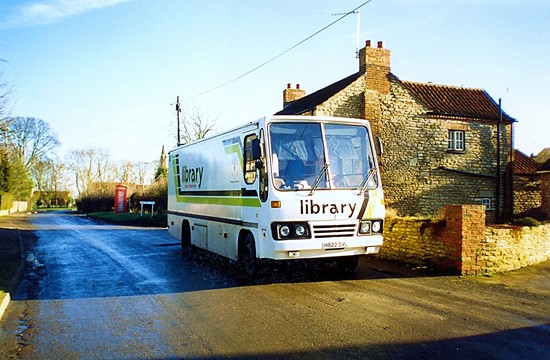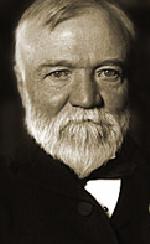|
Bourne public library
The first library in Bourne is
believed to have been that opened by William Daniell, printer, bookseller
and stationer, in 1825 at his premises in the Market Place from where he
traded until circa 1850. His new venture was proudly announced in a public
notice published by the Stamford Mercury on Friday 18th November
which said: "In the course of the next few weeks, W D will open a new
circulating library which will consist of novels, tales, romances etc.
Catalogues will be printed and may be had on application as soon as
arrangements are made for the commencement." The reading room opened on New Year's Day, Thursday 1st January 1863, at rented accommodation in the Market Place adjoining the tailor's shop at No 1 North Street run by Mr William Todd. A committee was appointed to run it with the vicar, the Rev Joseph Dodsworth, as president. The others were his curate, the Rev J P Sharp (chairman), W Webber and J B Roberts (joint secretaries), H Torkington (treasurer), and members H Osborn, T Harrison, W Sang, T Presgrave, R Y Roberts, W R Wherry and W Chapman. There were initially 60 subscribers at 12s. a year and the opening hours were from 10 am until 10 pm. The Stamford Mercury reported on Friday 2nd January: "No doubt a well conducted reading room in Bourne will be useful and it augers well for the success of the undertaking that the committee contains the names of several persons likely to attend to the business connected with it in such a manner as to attain the desired object of a large number of subscribers. The terms are very moderate and the room engaged for the purpose is a very convenient one." Mr William Parker of Hanthorpe House became an annual subscriber of two guineas and the vicar promised one guinea and by the end of February, the reading room had already become well established. "The number of members and the attendance nightly show that it is appreciated by the young men of the town", reported the Stamford Mercury on Friday 27th February 1863. "Mr Thomas Mawby has placed in the room a set of Staunton chess men and board. It is hoped that with a few additions to the annual subscribers, the committee will be able to maintain and increase the usefulness of the institution." The following year, the possibility of opening a circulating library was mooted at the quarterly meeting of the reading room committee held on Tuesday 11th October 1864. "The object is looked upon as desirable", reported the Stamford Mercury, "and will supply a need that has long been felt. The proposed terms of subscription are such as to place it within the power of all classes to become members. But as the commencement of the undertaking will entail considerable expenses, such as a stock of books, book shelves, printing etc, it is hoped the town will liberally respond to the application of the committee for donations." Mr Parker was again among the first contributors with a donation of £3 and the promise of an annual subscription of £1 to the library fund. Sir John Trollope followed with a £2 donation and a similar annual subscription while other income came from penny readings at the Assembly Rooms in the Angel Hotel which raised £35 during the winter session. A total of £45 was eventually raised to provide books and in the first few years if its existence, a further £250 was spent on more volumes, periodicals, binding materials and the production of a catalogue. The reading room and library continued using the Market Place premises until the first week in January 1871 when it moved to the newly built Corn Exchange where accommodation had been specially provided. The Stamford Mercury carried public notices on Friday 8th January announcing: The Bourne Library and Reading Room removed to the new Corn Exchange and Public Hall. Arrangements have been made whereby subscribers residing in the country, and those to whom the regular hours for changing are inconvenient, can have their books changed any day between 10 am and 8 pm. A list of books lately added will be published in a few days, The library now contains upwards of 1,000 volumes. Subscriptions: 5s., 10s. and 12s. per annum. It is particularly requested that all books be returned to the library for comparison with catalogue on or before Saturday, January 14th. Gentlemen not residing in the town of Bourne are admissible to the Reading Room on payment of one penny per day or three shillings per annum. - William Webber, honorary secretary. Mr Webber, headmaster of the Old Grammar School, was joint secretary in the early years of the library but resigned in 1872 because he could no longer spare the time from his scholastic duties, and he was succeeded by Mr R Wyles, a local chemist. But the library was continually hampered by lack of funds. Subscriptions were always less than expenses and there was no other income except occasional donations from charitable townspeople. Various attempts were made to raise additional money and on Tuesday 6th February 1872, a concert was held at the Corn Exchange for this purpose but it was not entirely successful. "The front seats were well filled and in the second seats there was a tolerable attendance", reported the Stamford Mercury. The decline continued and the annual general meeting on Monday 30th December 1872 was told that the accounts for the reading room had a debit balance of £2 10s. while the library funds showed a balance of only 50s. in favour of the institution despite the sale of old newspapers once they had become out of date. Nevertheless, members agreed to continue and optimistically elected new officers, Mr E T Wigelsworth (secretary) and Mr Thomas Young (treasurer). There was still no improvement and in June 1875, the financial situation had become so desperate that the committee refused to accept further responsibility for the ordering of daily and weekly newspapers and magazines and the library and reading room closed soon afterwards. The Stamford Mercury was shocked and their correspondent reported: "Now that so suitable and comfortable a room is provided in the public hall for the library and reading room, it is a pity, if not a disgrace to the town, should there not be found sufficient public spirit to maintain this institution in an efficient manner." This gap in the market was subsequently filled by a commercial Reading Room and Subscription Library operated by Mr John T Morris, a newsagent and bookseller of No 13 West Street. By 1885, his library contained upwards of 1,000 volumes and the reading room was open daily from 8.30 am to 8.30 pm with all of the principal newspapers available to subscribers on payment of one penny per visit. This facility continued until the early years of the 20th century when Mr Morris retired and sold the premises although a circulating library, known as the Novel Library, operated from premises in North Street during the 1930s. A library was also attached for a time to a Temperance Café and Working Men's Institute that was opened in 1880 at premises in South Street by the Bourne Temperance Society as an alternative to the public houses. This venture was run as a limited company but encountered financial difficulties and closed down in 1885 but after a period of re-organisation, the premises were completely renovated in 1888 and continued on a voluntary basis as a public library until the opening of the Bourne Institute in West Street in 1896. Within a short space of time, this had amassed 400 books, a remarkable collection at a time when they were prized possessions and eagerly sought after by those anxious to read and expand their knowledge of the world. The first free public lending library in the town to be run by the local authority was based at the old National School in North Street [now the headquarters of the Grantham and Stamford Conservative Association] and was opened on 14th November 1924. This was part of the Rural Library Scheme launched by the education committee of Kesteven County Council and was equipped by the Carnegie United Kingdom Trust that had presented them with 4,000 volumes of which Bourne had 240. The working expenses were met out of public funds and the library was intended mainly to help students requiring a higher standard of work to study in any particular subject and who could obtain the books they needed by paying the cost of postage to and from London where the Central Library for Students was based. The official opening of the new library was attended by Mr W T Phipps, the Chief Education officer for Kesteven County Council, Miss Charlesworth, the county librarian, members of the local committee and many users of the library which was already in operation. Mr Phipps told the gathering that borrowers would find the library a source of pleasure and profit and was regarded as an alternative to evening continuation classes for students who wished to progress with their learning in their own time and at their own speed. All residents of Bourne, however, were eligible to apply for the loan of books, except children attending the new secondary school which had a library of its own. This modest library continued to operate until the outbreak of the Second World War in 1939 and it was not until 1953 that a more permanent home was found. In July of that year, Kesteven Education Committee arranged to lease a room at the Bourne Institute in West Street, now the Pyramid Club, for an initial period of five years for use as a branch library. The rental was £1 a week although the council also footed the bill to decorate and equip the room at a cost of £400 and appointed a part-time librarian at a salary of £150 a year. In the event, the library continued to operate from these premises for the next thirty years and as the volume of books on offer and the number of borrowers greatly increased during that time, the accommodation eventually became inadequate to continue serving the expanding population. A new purpose built library was therefore planned and in 1967, Kesteven County Council bought a site in Abbey Road and started drawing up plans for the new building. At that time, Lincolnshire was divided into three county sub-divisions, Holland, Lindsay and Kesteven, and Bourne was administered by the latter until the local government re-organisation of 1976. There was some difficulty in obtaining loan sanction for the project because at that time, government policy was not in favour of local authorities building new branch libraries but the scheme was overtaken by events. In the spring of 1968, Britain's Civil Defence was deemed to have outlived its usefulness and was stood down and this left the county council with an empty building in South Street. The premises here had been purpose-built for the organisation, having been designed by their own architects between 1963-64 and completed the following year. The building was therefore redundant and was immediately earmarked for use as the town's public library. Some improvement work was needed to the building but the county council decided that overall, it would be £4,300 cheaper to adapt the premises as a library rather than build a new one in Abbey Road although they would keep the site for a trial period of two years to ensure that the new premises were a success. Conversion work cost £625 to turn the Civil Defence centre into a public library but a further £2,450 was spent on remedial work such as improved lighting and drainage, re-surfacing the outside area and the provision of new furniture and equipment. The work was completed early in 1969 when the library service was transferred from the institute in West Street. The population of Bourne however was expanding fast and it soon became apparent, that the original layout of the premises was totally inadequate and in 1981, a £40,000 improvement scheme was approved by Lincolnshire County Council who had taken over library services in Bourne under the local government re-organisation. The work took 16 months to complete and during this period, a temporary library operated from the showrooms of the Jubilee Garage in Abbey Road. The re-designed building is as we see it today, providing a modern open-plan layout and including better facilities for customer lending, a children's section and an administration area. Floor and shelving space was increased to accommodate 14,000 books instead of the 10,000 previously in stock. A novel feature of the re-designed library called The Pit Stop was included in the children's section and consisted of two model racing cars fitted with extra seats and containing books for very young children. The cars were built by pupils of Bourne Secondary School (now the Robert Manning Technology College) to designs prepared by the county architect's department and reflected local interest in Raymond Mays (1899-1980), the international driver and designer of racing cars, who lived and worked in Bourne.
The overall improvement scheme was prepared by Mr Vin Leeman of the county architect's department and the building work undertaken by Messrs E Bowman and Sons of Stamford who completed the contract ahead of schedule which allowed the library to re-open to the public on Thursday 3rd February 1983. An official opening was held the following Wednesday 9th February by Councillor Brian Gledhill, vice-chairman of the county council's leisure and recreation committee, and attended by the Mayor and Mayoress of Bourne, Councillor and Mrs Norman Thwaite, and local county councillors Don Fisher and Ray Cliffe. Since then, the library has become an increasingly popular community amenity complete with a well-stocked reference section containing a large quantity of local archive and an area for quiet study. Four computers have also been recently installed and for a small fee, visitors can either brush up on their PC skills or surf the Internet. A notice board in the entrance hall is crammed with announcements from local groups holding meetings or recruiting members while inside the main door there is often a bargain shelf containing old books that have been replaced and offered for sale, usually for a few pence.
The library is also used for a variety of other associated activities including displays, poetry reading and story time sessions for children and even on occasions, book signings and it was here that the late Lorenzo Warner, founder of the local printing
firm Warners Midlands plc, spent a day in August 1989, autographing copies of his biography Born with the Century by Anne Frazer Simpson that had recently been published. Although only small by comparison with some towns in Lincolnshire, the library stock had increased to 23,571 books by March 2001 but borrowers are able to choose from the entire selection owned by the county service through a computer link that ensures delivery of any volume as soon as it is available. Further modernisation was carried out in the summer of 2010 when the library was closed for two weeks while the work was carried out. Bourne was among the first of the smaller libraries in the county to benefit from a new £29,000 system of self-service computer units providing convenient and easy-to-use technology for borrowers and so free up valuable staff time. There were also improvements in Internet access for the bank of computers and the introduction of new book stocks. Staff spent some time at Stamford library during the closure to enable them become familiar with the new technology.
The library in South Street closed early in
2013 and the entire service transferred to the new Bourne Community Access
Point which had been established at the Corn Exchange where the official
opening took place on Wednesday 6th March. The move was made as a result
of enforced cuts in public spending which has resulted in a reduced
service. There are fewer books, the reference library has disappeared
although some volumes on local history have been retained, the area for
study has also gone and there is a smaller children' section, although the
bank of computers for public use has been retained.
REVISED MAY 2015 See also Bourne Community Access Point Civil Defence A visit to the library The future of our public libraries
Go to: Main Index Villages Index |
||||||||||||
